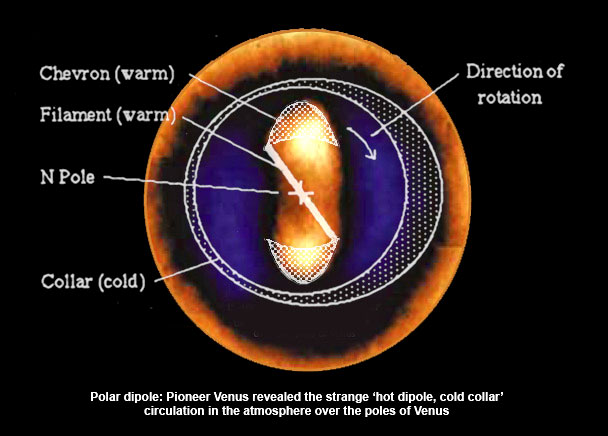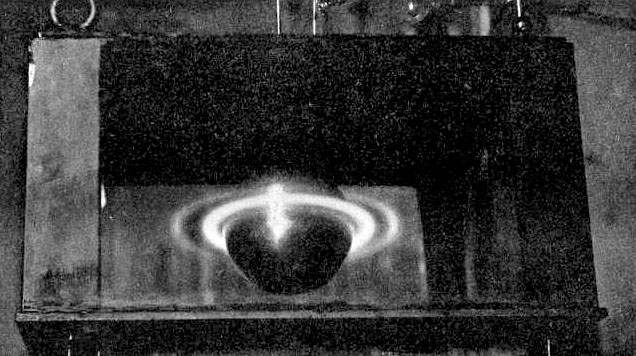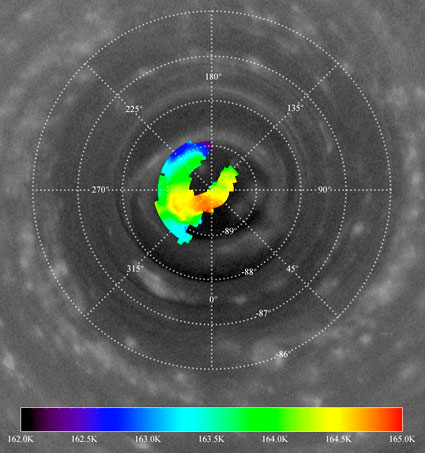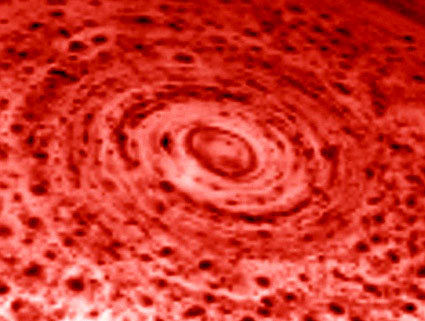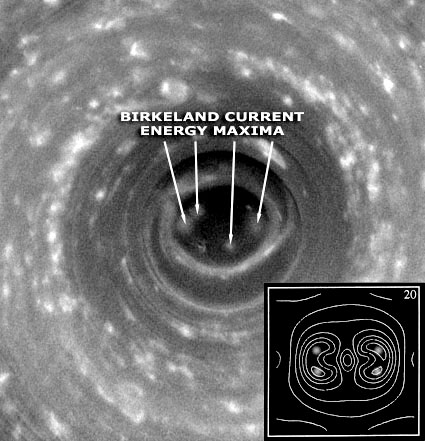|
by Wal Thornhill 20 November 2006
from
HoloScience Website Poincaré, at the conclusion of the preface to his book, 'Hypothéses Cosmogoniques', states,
Nothing has changed in 100 years. Spiral
galaxies remain an enigma to astrophysicists who have had to resort
to magical 'dark matter' in an attempt to save appearances.
Consequently there is no recognition of a connection with other
spiral forms seen much closer to home.
For example,
If the test of a good theory is successful predictions, the Electric Universe is unparalleled.
Even better if it can simply explain
details in the new images of Saturn's south pole.
Cassini stares deep
into the swirling hurricane-like vortex at Saturn’s south pole,
where the vertical structure of the clouds is highlighted by
shadows. From the NASA report:
A movie taken by Cassini's camera over a
three-hour period reveals winds around Saturn's south pole blowing
clockwise at 550 kilometers (350 miles) per hour. The camera also
saw the shadow cast by a ring of towering clouds surrounding the
pole, and two spiral arms of clouds extending from the central ring.
These ring clouds, 30 to 75 kilometers (20 to 45 miles) above those
in the center of the storm, are two to five times taller than the
clouds of thunderstorms and hurricanes on Earth.
Infrared images taken by the Keck I telescope in Mauna Kea, Hawaii, had previously shown Saturn's south pole to be warm. Cassini's composite infrared spectrometer has confirmed this with higher-resolution temperature maps of the area. The spectrometer observed a temperature increase of about 2 Kelvin (4 degrees Fahrenheit) at the pole.
The instrument measured high temperatures in the upper troposphere and stratosphere, regions higher in the atmosphere than the clouds seen by the Cassini imaging instruments.
The above diagram shows the main characteristics of the Venusian polar dipole. The diameter of the collar is about 5000 km and the temperature contrast between the hottest part of the chevron and the coldest part of the collar is about 45 K.
Credit: F. W. Taylor.
Composite image: W. Thornhill. In April 2006 I wrote,
Professor Taylor had written earlier about the Venusian north polar vortex:
So there was no reason, other than an appeal to symmetry, for scientists to expect a similar vortex at the south pole of Venus.
Based on the electrical model, I
predicted that Venus' south pole would also have a vortex. I make
the same prediction for Saturn's opposite (north) pole. Cassini
scientists are unsure because the north pole is in darkness and
receives no solar heat.
Twenty years later, this has not been done.
The inertia of institutional specialization infects modern
science and education. Astrophysicists with inappropriate and narrow
training remain in control. Meanwhile the puzzles facing the space
sciences multiply by the day and falsifiable predictions (the best
test of a good theory) are rare—and even more rarely successful.
This contrasts starkly with the Electric Universe model, which
recognizes Alfvén's pioneering insights and has many successful
predictions to its credit, including this one on Saturn.
Birkeland showed experimentally how Saturn's enigmatic rings could be the result of an electric discharge to a magnetized sphere, representing the planet, and acting as the cathode.
From Kristian Birkeland's series, 'The Norwegian Aurora Polaris Expedition 1902-1903,'
Volume 1: On the
Cause of Magnetic Storms and The Origin of Terrestrial Magnetism,
published in 1908. After 100 years Birkeland's simple electrically driven model is unmentioned in astrophysics textbooks!
It is a disturbing illustration that astrophysics has no interest in
experimental evidence that doesn't fit the dogma of an electrically
inert universe. For this and other reasons, history will view the
20th century as a dark age of science. It is perhaps unfortunate
that burgeoning technology has masked the stagnation in fundamental
science.
Dessler called them 'Birkeland currents,' a term which is now generally accepted and sometimes generalized to mean all currents flowing parallel to the ambient magnetic field.
This figure shows the forces between two adjacent Birkeland current filaments following auroral magnetic field lines. The parallel components of current are long-range attractive, while the counter-parallel azimuthal currents are short-range repulsive. These forces cause the currents to form sheets, filaments, or 'magnetic ropes' and they can be found far from the source region.
A projection of the
current-induced magnetic fields is shown above the graph.
This figure shows a time sequence of contours of magnetic energy in cross-section between two Birkeland filaments.
The contours at the
locations of the two filaments correspond to energy maxima while the
central ellipse is an energy minimum.
It is this behavior of twin Birkeland current filaments that explains the detailed features of Saturn's polar 'hurricane'.
The view shows temperature data from the Cassini spacecraft Composite Infrared Spectrometer (CIRS) overlaid onto an image from the Imaging Science Subsystem (ISS) wide-angle camera. The CIRS data refer to a depth in Saturn’s upper stratosphere where the pressure is 0.5 millibars (324 kilometers above the 1-bar level).
The CIRS data show a
very small hot spot over the pole, similar in size to the “eye” of
the storm seen in ISS images. The image above, while being incomplete, supports the electrical model. At around 300˚ we see the yellow-reddish cusp feature of one Birkeland filament. At intervals, heated gas from that filament is 'squirted' in a thin jet into the central 'sump,' indicated by the reddish patch over the pole.
The inward jets alternate between the two filaments so we may expect the pattern to be repeated where the infrared data is missing.
The individual storms surrounding the pole are seen as dark "leopard spots" in the thermal image. The large number of dark, circular “leopard spots” at the south pole seen at 5000 nm wavelength, and their correlation with the features seen in sunlight at 2800 nm wavelength, indicates that convective activity extending over dozens of kilometers in altitude is surprisingly rampant in the south polar region. Why such unusual dynamics exist there is perhaps linked to Saturn’s southern summer, which is the season Saturn is in now. Observations taken over the next few years, as the south pole season changes from summer to fall,
will help scientists
understand the role seasons play in driving the dramatic meteorology
at the south pole of Saturn.
The seasons play little role on Saturn, which is almost 10 times further from the Sun than the Earth and the solar heating only 1% of that here. The center of the 'storm' is fixed over the pole because it is an electrical discharge phenomenon linked to Birkeland currents that follow Saturn's neatly aligned magnetic field directly to the planet's pole of rotation. The spiral pattern is most clearly seen in this infrared image and the two cusps are evident inside the central ring of clouds.
And the pattern of dark spots in the
polar region is best explained by electric discharges.
The lighter spots in the polar 'eye' seem to coincide with the energy maxima seen earlier in the computer simulation of the energy distribution between two Birkeland current filaments [inset]. They are presumably formed by gases raised high into the stratosphere by the electric discharge, where they condense to form haze patches. Magnetohydrodynamic or thermal models of Saturn's atmospheric flows do not answer to such an unusual and specific pattern. The rotating Birkeland filaments and ionospheric currents form part of a circuit that drives the surprising high-speed upper atmosphere winds on Venus, Titan, Saturn and the other outer planets, not solar or internal heating.
It is clear why Professor Taylor and other specialists are,
The primary energy source in the
universe has been overlooked.
|


